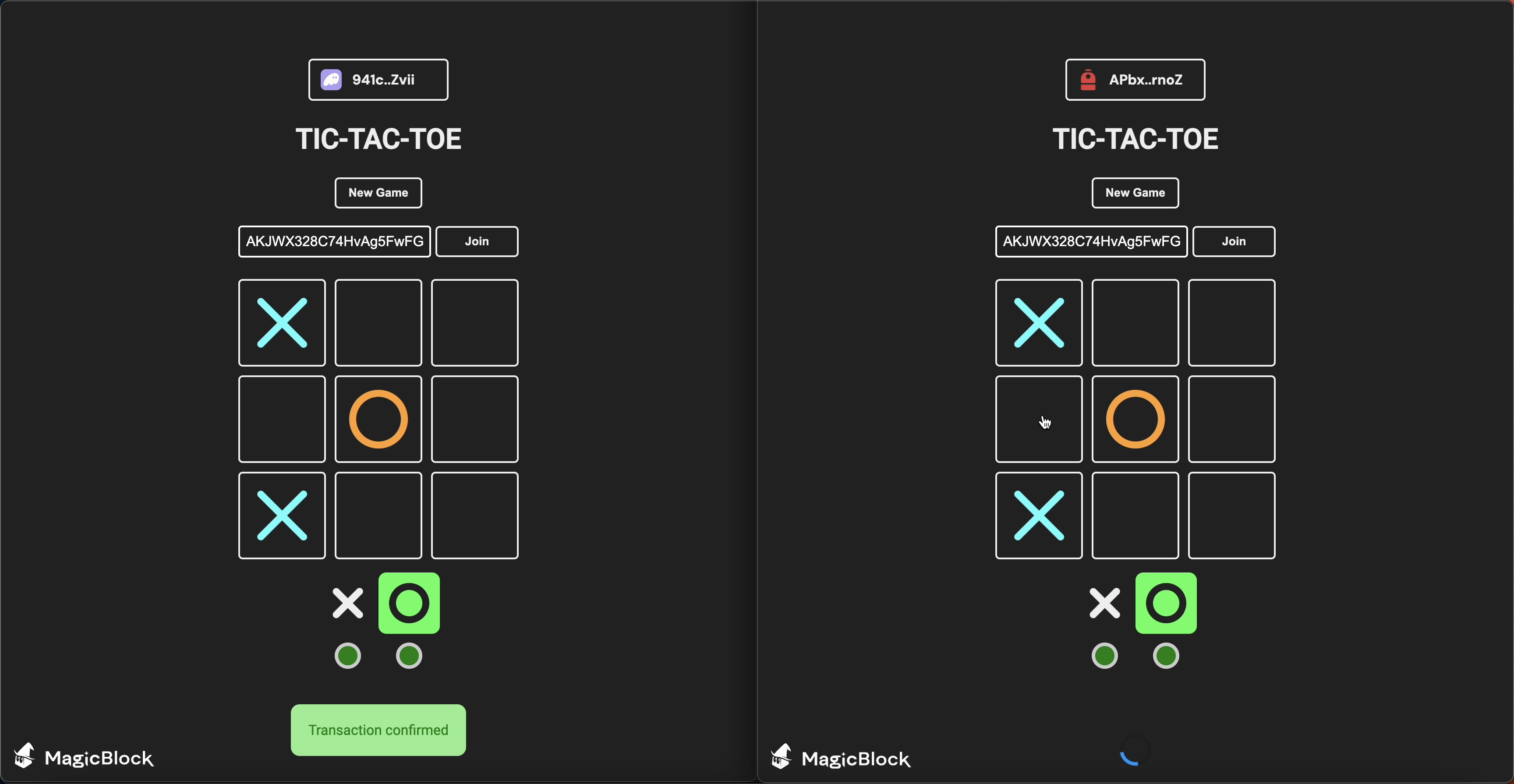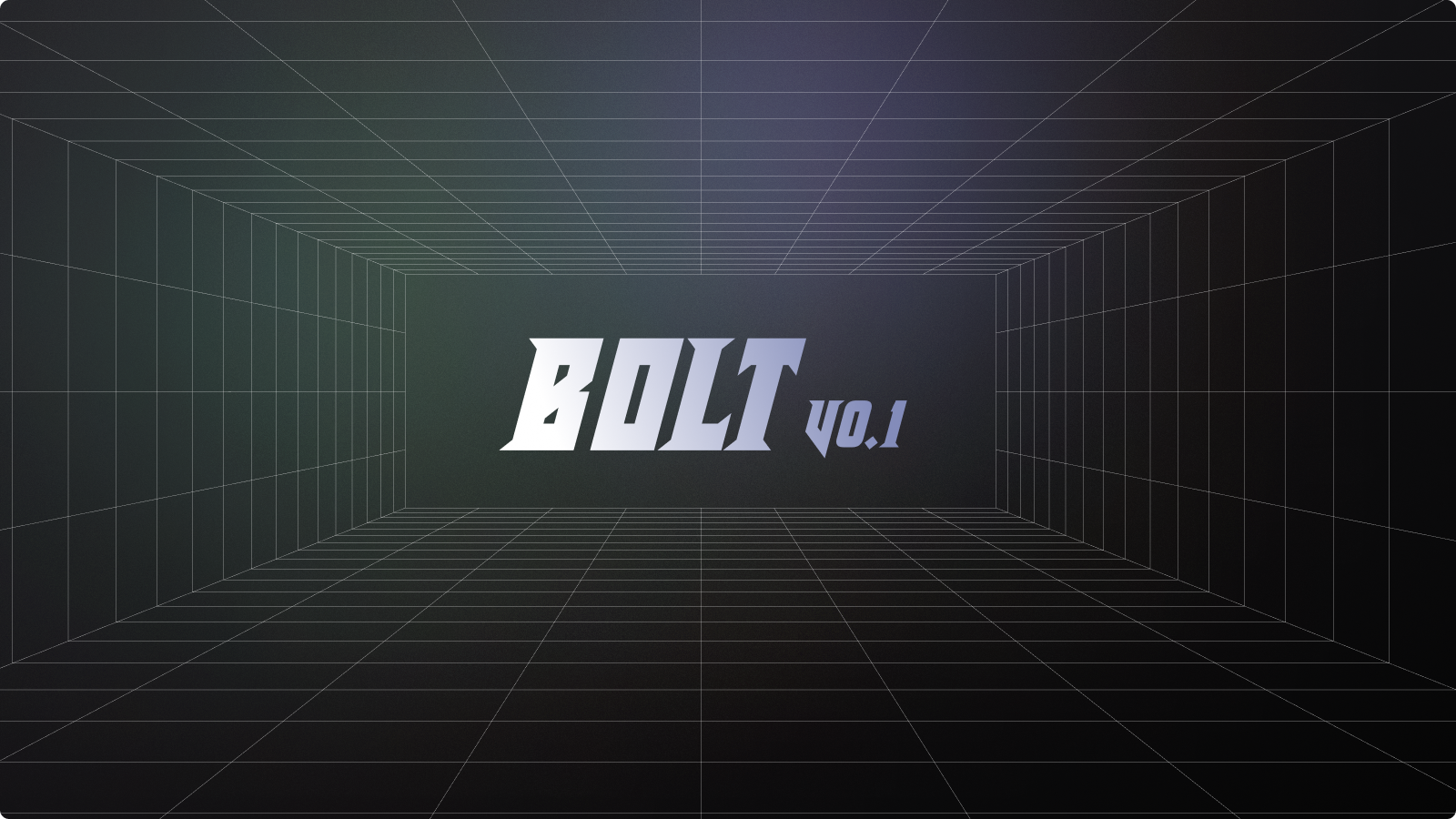In this article, we showcase a simple game example developed using the Bolt Entity Component System (ECS), which facilitates reusability of components and enables users to modify and extend the game’s logic.
The framework significantly simplifies Solana development by abstracting low-level concepts such as account space and Program Derived Addresses (PDAs). For comparison with an Anchor-based program, refer to this tutorial.
For a more detailed explanation of Bolt, see the announcement blog post.
Implementing Tic-Tac-Toe
The first section of this post details the implementation of the game logic using the Bolt framework. The second section explains how to integrate a React-based client with the program, starting with an open-source Tic-Tac-Toe implementation.
The complete source code of the example is available here.
The Game Logic: Implementing Tic-Tac-Toe with the Bolt ECS
First, install the bolt-cli with:
npm install -g @magicblock-labs/bolt-cli
Once installed, create a new project with:
bolt init tic-tac-toe
Creating the Components
We need to define the data structures required. For simplicity, we will create two components: one containing the active players and the other containing the grid information.
Create a new components with:
bolt component players
This command creates a players component under program-ecs/components. The players component, which holds the public keys of the two players, can be defined as follows:
use bolt_lang::*;
declare_id!("5Xz6iiE2FZdpqrvCKbGqDajNYt1tP8cRGXrq3THSFo1q");
#[component]
#[derive(Default)]
pub struct Players {
pub players: [Option<Pubkey>; 2],
}
The second component contains the grid information. Create it with:
bolt component grid
The grid component can be defined as:
use bolt_lang::*;
declare_id!("rdiVoU6KomhXBDMLi6UXVHvmjEUtKqb5iDCWChxMzZ7");
#[component]
pub struct Grid {
pub board: [[Option<Sign>; 3]; 3],
pub state: GameState,
pub is_first_player_turn: bool,
}
#[component_deserialize]
#[derive(PartialEq)]
pub enum GameState {
Active,
Tie,
Won { winner: Pubkey },
}
#[component_deserialize]
#[derive(PartialEq)]
pub enum Sign {
X,
O,
}
impl Sign {
pub fn from_usize(value: usize) -> Sign {
match value {
0 => Sign::X,
_ => Sign::O,
}
}
}
impl Default for Grid {
fn default() -> Self {
Self::new(GridInit{
board: [[None; 3]; 3],
state: GameState::Active,
is_first_player_turn: true,
})
}
}
Creating the Systems
Systems implement the game logic in a modular fashion. They operate on a bundle of input components and can perform any computation. Systems are executed in your world instance subject to the approval policy, e.g., a world could allow anyone to submit new systems, while another could require approval from whitelisted parties or a DAO.
The first system we build will allow a player to join a match:
bolt system join-game
Modify the logic (in program-ecs/systems/join-game.rs) to:
#[system]
pub mod join_game {
pub fn execute(ctx: Context<Components>, _args_p: Vec<u8>) -> Result<Components> {
let players = &mut ctx.accounts.players.players;
let idx = match players.iter_mut().position(|player| player.is_none()) {
Some(player_index) => player_index,
None => return Err(PlayersError::GameFull.into()),
};
ctx.accounts.players.players[idx] = Some(*ctx.accounts.authority.key);
Ok(ctx.accounts)
}
#[system_input]
pub struct Components {
pub players: Players,
}
}
The second system implements the core logic of the game:
-
Create a play system:
bolt system play -
Implement the logic:
use bolt_lang::*;
use grid::Grid;
use players::Players;
declare_id!("DyUy1naq1kb3r7HYBrTf7YhnGMJ5k5NqS3Mhk65GfSih");
#[system]
pub mod play {
pub fn execute(ctx: Context<Components>, args: Args) -> Result<Components> {
let grid = &mut ctx.accounts.grid;
let players = &mut ctx.accounts.players;
let authority = *ctx.accounts.authority.key;
require!(players.players[0] == Some(authority) || players.players[1] == Some(authority), TicTacToeError::NotInGame);
require!(grid.state == grid::GameState::Active, TicTacToeError::NotActive);
let player_idx : usize = if players.players[0] == Some(authority) { 0 } else { 1 };
require!(grid.is_first_player_turn == (player_idx == 0), TicTacToeError::NotPlayersTurn);
// Core game logic
match args {
tile @ Args {
row: 0..=2,
column: 0..=2,
} => match grid.board[tile.row as usize][tile.column as usize] {
Some(_) => return Err(TicTacToeError::TileAlreadySet.into()),
None => {
grid.board[tile.row as usize][tile.column as usize] =
Some(grid::Sign::from_usize(player_idx));
}
},
_ => return Err(TicTacToeError::TileOutOfBounds.into()),
}
grid.is_first_player_turn = !grid.is_first_player_turn;
check_winner(grid, authority);
Ok(ctx.accounts)
}
#[system_input]
pub struct Components {
pub grid: Grid,
pub players: Players,
}
#[arguments]
struct Args {
row: u8,
column: u8,
}
}
pub fn check_winner(grid: &mut Account<Grid>, player: Pubkey) {
...
}
Refer to the full source code for details.
As you can notice, the implementation is incredibly simple. The struct marked with system_input define the components input bundle, that can be accessed and used in the execute function. the struct marked with arguments define the arguments that your system can receive as input.
Build and Test the Program
Build the program with:
bolt build
This command compiles the program and generates the IDL and TypeScript types automatically for client integration.
The process for setting up components and executing the systems involves the following steps:
- Instantiate a world.
- Create a match entity.
- Attach the players and grid components to this match entity.
- Execute the systems to facilitate gameplay.
The TypeScript tests for the Tic-Tac-Toe game can be found here:
Connect a React Client
Connecting a React client is straightforward, thanks to the dynamic retrieval and generation of types and the utility functions provided by the Bolt TypeScript SDK.
Add the dependency with:
yarn add -D @magicblock-labs/bolt-sdk
For example, to execute a system:
// Components
const GRID_COMPONENT = new PublicKey("rdiVoU6KomhXBDMLi6UXVHvmjEUtKqb5iDCWChxMzZ7");
const PLAYERS_COMPONENT = new PublicKey("5Xz6iiE2FZdpqrvCKbGqDajNYt1tP8cRGXrq3THSFo1q");
// Systems
const JOIN_GAME = new PublicKey("2umhnxiCtmg5KTn4L9BLo24uLjb74gAh4tmpMLRKYndN");
const PLAY = new PublicKey("DyUy1naq1kb3r7HYBrTf7YhnGMJ5k5NqS3Mhk65GfSih");
const applySystem = await ApplySystem({
authority: publicKey,
system: JOIN_GAME,
entity,
components: [PLAYERS_COMPONENT],
});
const transaction = applySystem.transaction;
const signature = await submitTransaction(transaction);
Find the simple Tic-Tac-Toe UI made in React here: react-tic-tac-toe
An important aspect to highlight is that executing systems and instantiating components require only the ID. This means that new logic and data structures can be created and utilized dynamically, enabling the development of mods and alterations to your game’s behavior.
Conclusion
We have walked through a simple implementation of a Tic-Tac-Toe game using the Bolt ECS, demonstrating how to connect it to a React UI. This highlights the simplicity and flexibility of the framework. In addition to abstracting Solana and reusing onchain logic, we are excited about the unlocks BOLT will introduce for user-generated logic and mods. In follow-up examples, we will show how a game developer could independently and permissionlessly extend the logic of a game and how to achieve low latency/high troughput transactions using the ephemeral rollups.

 BOLT engine: unstoppable and composable games
BOLT engine: unstoppable and composable games